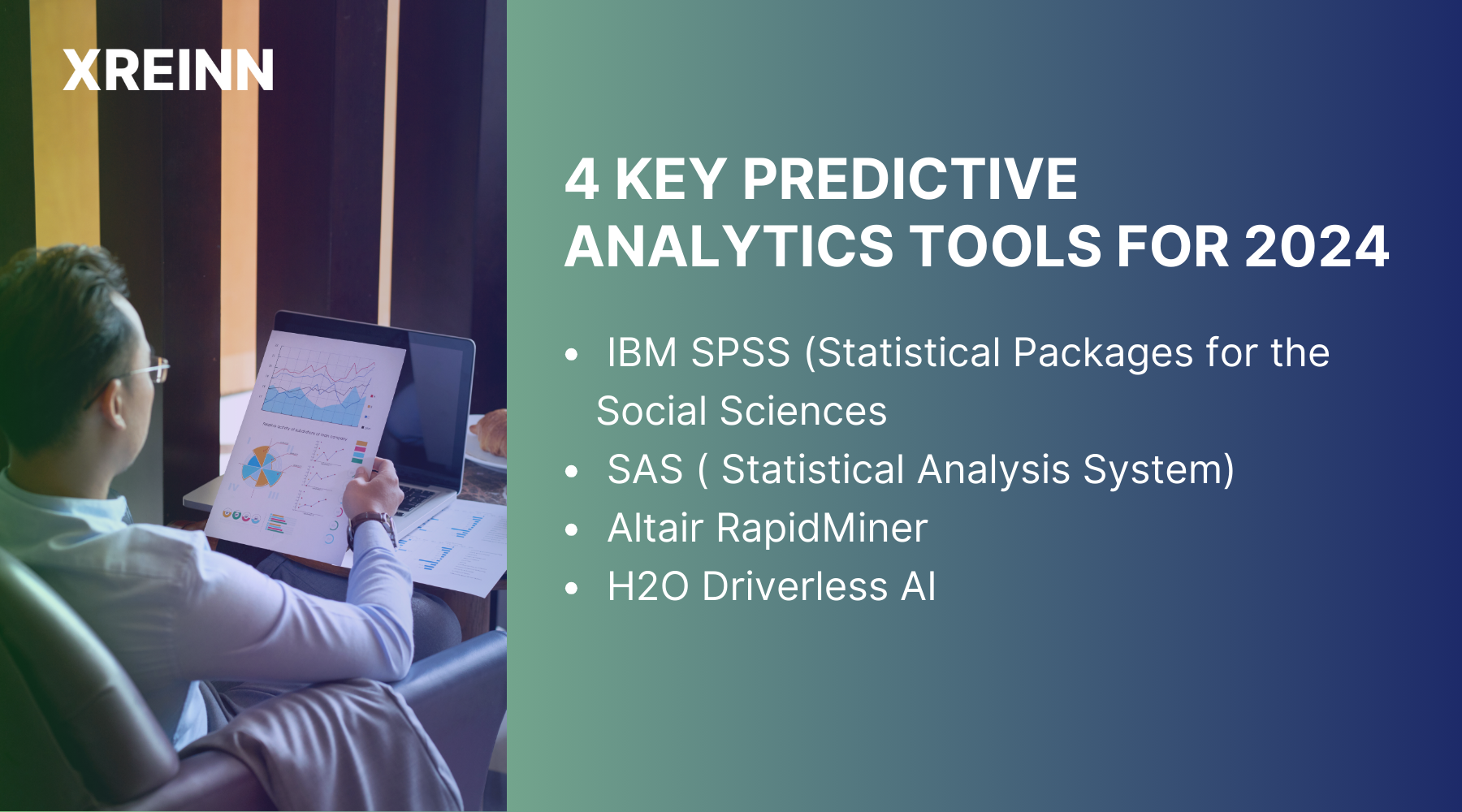Data Analytics
Smarter Decisions with Predictive Analytics: How It Works?
Jul 06, 2024
Predictive analytics transforms raw data into actionable insights, enabling businesses to make informed decisions. By examining historical data, it forecasts future trends, helping organizations predict outcomes and optimize strategies. In an information-centric world, understanding predictive analytics can give you a competitive edge, streamline operations, and drive growth.
In the article below read more about how predictive analytics, along with predictive modeling, and various tools, play a crucial role in making smarter decisions, overcoming challenges, and measuring success.
What is Predictive Analytics?
Predictive analytics is the practice of using historical data, statistical algorithms, and machine learning techniques to identify the likelihood of future outcomes based on past data. It involves analyzing patterns and trends to make forecasts and inform decision-making processes. By changing predictive modeling, businesses can predict events, optimize strategies, and gain insights that drive proactive actions.
This approach helps in various applications such as risk management, marketing optimization, customer behavior prediction, and operational efficiency improvement. This makes it a crucial tool for data-driven decision-making.
Predictive Modeling
Predictive modeling is the backbone of predictive analytics. It involves using statistical techniques and algorithms to create models that predict future outcomes based on historical data. These models can range from simple linear regression to complex machine-learning algorithms. By understanding the components and techniques of predictive modeling, you can better utilize these models to forecast future events.
For example, if you're in retail, predictive modeling can help you forecast sales, manage inventory, and even personalize customer experiences.
The Role of Data Analytics in Better Decision-Making
Data analytics has revolutionized how businesses operate, providing a wealth of information that drives decision-making. When you change predictive analytics, you gain insights that go beyond basic data interpretation. It helps you identify patterns, predict trends, and make proactive decisions.
This proactive approach ensures that your business remains agile and responsive to market changes. By integrating predictive analytics into your decision-making process, you can better understand customer behavior, optimize marketing strategies, and improve operational efficiency.
Forecasting Techniques in Predictive Analytics
Forecasting techniques are essential tools within predictive analytics. They help you predict future events based on historical data and trends. Some common forecasting techniques include time series analysis, regression analysis, and machine learning algorithms.
Time series analysis, for example, is particularly useful for predicting trends over time, such as sales forecasts or stock prices. By mastering these techniques, you can make more accurate predictions and plan accordingly, ensuring that your business stays ahead of the curve.
4 Key Predictive Analytics Tools for 2024

Here are four of the most popular predictive analytics tools to consider.
IBM SPSS
IBM SPSS (Statistical Package for the Social Sciences) is a comprehensive tool for statistical analysis and predictive modeling. It offers a user-friendly interface and a wide range of features, including data management, statistical analysis, and graphing capabilities. SPSS is widely used in social sciences, health sciences, marketing, and other fields for conducting sophisticated analyses and generating predictive models.
SAS
SAS (Statistical Analysis System) is renowned for its advanced analytics capabilities. It provides tools for data management, statistical analysis, predictive analytics, and more. SAS's strong and user-friendly interface makes it accessible for both beginners and experts. It's commonly used in industries like finance, healthcare, and retail for its powerful data handling and predictive modeling capabilities.
Altair RapidMiner
Altair RapidMineris a powerful tool that simplifies the process of building predictive models. It provides an integrated environment for data preparation, machine learning, deep learning, text mining, and predictive analytics.
RapidMiner's drag-and-drop interface makes it accessible for users with varying levels of expertise. It enables them to design, deploy, and maintain predictive models efficiently. It's used across different industries for its ease of use and comprehensive analytics capabilities.
H2O Driverless AI
H2O Driverless AI is an advanced tool that automates the machine learning process. It uses automated feature engineering, model validation, and hyperparameter tuning to deliver high-quality predictive models. H2O Driverless AI is known for its speed and accuracy, making it a favorite among data scientists for developing strong predictive models quickly. Its ability to handle large datasets and integrate with other data platforms enhances its utility across various industries
Data-Driven Strategies for Business Growth
Implementing data-driven strategies is crucial for achieving business growth. Predictive analytics allows businesses to change their data to uncover new opportunities and optimize existing processes. For example, identifying different customer segments based on behavior and preferences helps customize marketing strategies.
Predicting future sales trends optimizes inventory management and improves sales strategies. Identifying customers at risk of leaving enables proactive retention measures. Analyzing market trends and competitor strategies helps make informed business decisions. By adopting these strategies, you can make data-driven decisions that lead to sustained business growth.
Applications of Predictive Analytics
Predictive analytics has a wide range of applications across various industries. Here are a few real-world examples:
- Healthcare: Predictive analytics can help in predicting disease outbreaks, optimizing treatment plans, and managing patient care more effectively.
- Finance: It is used to forecast market trends, detect fraud, and manage risks.
- Retail: Retailers use predictive analytics to optimize inventory, personalize marketing efforts, and improve customer satisfaction.
- Manufacturing: It helps in predicting equipment failures, optimizing production schedules, and reducing downtime.
Challenges and Considerations in Implementation
Implementing predictive analytics is not without its challenges. Some common obstacles include:
- Data Quality: Poor-quality data can lead to inaccurate predictions. Ensuring data accuracy and completeness is crucial.
- Complexity: Predictive analytics involves complex algorithms and models that require expertise to develop and maintain.
- Cost: Implementing predictive analytics can be expensive, especially for small businesses.
- Integration: Integrating predictive analytics into existing systems and processes can be challenging.
Measuring Success of Predictive Decisions
Measuring the success of predictive decisions is crucial to ensure that your efforts are yielding the desired results. Some key metrics and KPIs to consider include:
- Accuracy: How close are your predictions to actual outcomes?
- ROI: What is the return on investment for your predictive analytics initiatives?
- Efficiency: Are your processes becoming more efficient as a result of predictive analytics?
- Customer Satisfaction: Are your predictions leading to improved customer experiences and satisfaction?
Conclusion
Predictive analytics offers a powerful way to transform data into actionable insights. It helps you make smarter, data-driven decisions. By understanding and changing predictive modeling, forecasting techniques, and predictive analytics tools, you can stay ahead of the competition and drive business growth. While there are implementation challenges, the benefits far outweigh the obstacles. By measuring the success of your predictive decisions, you can ensure continuous improvement and sustained success.

Data Analytics
Jun 27, 2024Master key concepts in data analytics with practical tips to enhance decision-making and achieve success in your projects and professional growth

Data Analytics
Jul 01, 2024Learn the essential stages of the data analytics workflow to turn your data into valuable business insights and drive growth.

